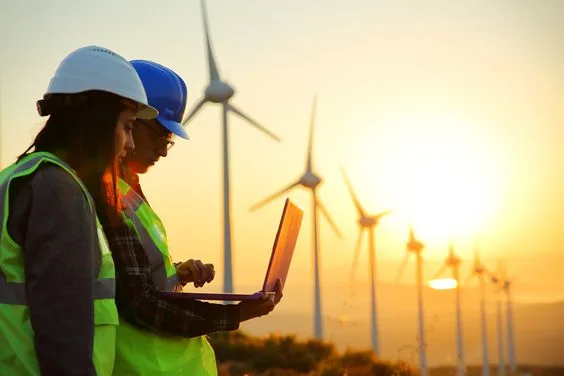Part two of a two-part series on green energy
When you turn on your lights and switch on your computers, how can you guarantee your business energy plan is actually green?
If you are on a standard business energy package and you switch to renewable energy, has your power supply changed? Has your energy become cleaner overnight?
The answer is that, unless you are hooked up to your own rooftop solar panels, the electricity flowing through your building is being supplied via the National Grid, just as before.
So why go green? What does switching to renewable energy actually mean? Is there any point?
The answer can only be found by looking at how we actually get our energy. And as to whether it is worth switching, the answer is, most certainly, yes!
How we get our energy
If you take a short stroll from Rubix VT HQ to the sea, you will be greeted with an incredible sight – the Rampion Offshore Wind Farm, the first offshore wind farm off the south coast of England.
It is a spectacular sight and is so enormous it can be seen clearly from the coast, even though the closest wind turbine is actually 13 km away. Stretching from East Worthing in the west, to Brighton in the east, and covering 72 square kilometers, the farm is bigger than Guernsey. The 116 turbines are an astonishing 140m tall, with rotor diameters of 112 meters.
The farm generates almost 1,400 Gigawatt hours (GWh) of power each year, enough to power half the homes in Sussex. So understandably, we’d quite like to tap into that local, sustainable energy to power up our office.
But we can’t just filter off some of that new wind energy to our office. The energy cables from the farm hit land in nearby Lancing, and the power surges inland to a substation at Twineham in Mid Sussex, where the electricity is converted to a higher voltage so it can feed into the network at Bolney National Grid substation.
Like all other businesses without independent generators, we power our office via the National Grid. The Grid supplies local networks of operators who lower the pressure and voltage, ready for businesses and homes.
You can probably spot the problem. How do we know that energy flowing in from the National Grid is from the local wind farm, or even if it is renewable at all?
The answer is we don’t. We have no control over the type of energy we TAKE from National Grid.
But what we can do is influence what type of energy the National Grid RECEIVES.
How energy suppliers source green energy
When you sign up for a green business energy plan, you will be guaranteeing that green energy enters the grid.
We will find the supplier which offers the right green package for you and they will do the rest. Effectively, the electricity you use, will be replaced by a green source.
Any reputable green energy supplier will be able to offer proof of its environmental credentials. These come in the form of contracts called Power Purchase Agreements (PPAs) or Renewable Energy Guarantees of Origin Certificates (REGOs).
In simplistic terms, a supplier might use PPAs for long-term energy provision and REGOs to cover fluctuations in demand.
For instance, an energy supplier might set up a PPA with a wind farm to guarantee a certain amount of energy for a fixed length of time. For the generator, a PPA can secure future revenues, while the supplier has a dependable source of electricity. Sometimes PPAs are signed before a wind farm, for instance, is even constructed, ensuring the viability of the project.
A PPA is ideal for a long-term partnership with a generator of green energy, but what happens when there is a spike in demand and suddenly more energy is needed?
In this case, the energy supplier can find a source of energy at short notice and the REGO will prove its green credentials. The certificates are provided by OFGEM, the regulator for the UK energy sector, as proof of where the energy is sourced from.
Battle of the big players
The Big 5 (it was the Big 6 – nPower has now been purchased by E.ON) UK suppliers are all proud of their green credentials. Their environmental claims include:
- ScottishPower has 40 operational wind farm sites in the UK
- British Gas is the largest energy supplier to gain certification from the Carbon Trust
- ON has biomass power plants in Lockerbie and Sheffield which create enough to power for 100,000 homes using material that would otherwise go to waste. E.ON also has 16 onshore wind farms in the UK.
- EDF has 37 onshore and two offshore wind farms, a 139-hectare solar farm and is currently adding solar panels on the roof of many Tesco stores.
- SSE is building Dogger Bank Wind Farm, the world’s largest offshore wind farm, more than 130km off the North East coast of England.
The battle to be the greenest is fierce, which is great news for businesses and households. The price of green energy has fallen to the extent it is almost on parity with non-green energy.
Which one to choose? It’s a difficult decision – which is where we can help.
Contact our Green Business Energy Sales Manager Felix Mushore, who will help you find a plan which is of great value and helps the planet.
Being environmentally friendly no longer costs the earth!






